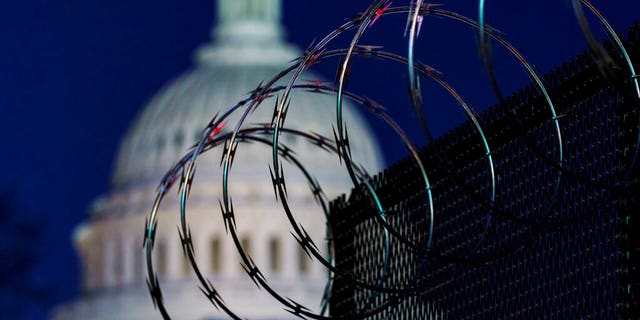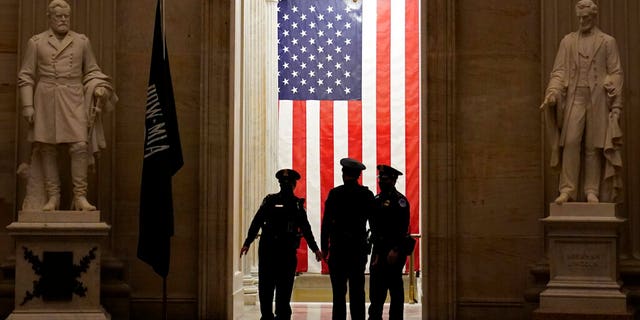Weeks after Capitol riot, scars both visible and invisible remain

DC National Guard to stay in Capitol through March
The National Guard deployment is extended amid concerns of more unrest; Lucas Tomlinson reports from the Pentagon.
I know of U.S. Capitol Police officers who are hurting. Smarting. Reeling. This, nearly a month after the insurrection at the Capitol they are paid to protect.
I know of Congressional aides who are hurting. Smarting. Reeling. This, after a violent mob shattered windows and jimmied doors, storming through the Capitol in which they work.
And these are the aides who weren’t at the Capitol on Jan. 6.
These were staffers working from home during the pandemic. They’re still upset after seeing an insurrection of the highest order in their workplace.
In this Jan. 19, 2021 photo, riot fencing and razor wire reinforce the security zone on Capitol Hill in Washington.
(AP)
And then there are the aides who were working at the Capitol on 1/6.
I know these aides are hurting. Smarting. Reeling.
They huddled for hours under desks. In a coat closets. In restrooms. Barricaded, in rooms, just as they were taught in a post-Columbine world.
This, as the violent horde marauded through Congressional offices and deployed Trump flagpoles like battering rams to break into the Speaker’s Lobby off the House chamber.
These are the scars which will take time to heal. But they are scars. And scars never disappear.
The United States Capitol bears ugly scars of that mortifying day. The lesions which remain are the hideous fencing encapsulating the Capitol, draped with spirals of concertina wire. There are the National Guard troops in fatigues, toting M5 carbines, guarding the American Capitol.
But the scars will remain in heads and hearts long after the troops depart.
An unsettling silence cloaks you once you enter the Capitol’s secure perimeter these days. You pass through the fencing, showing your pass a few times as you walk. You pass stretches of grass which is the Russell Senate Park.
It is a park in name only.
The grass is there. Some frost in winter. Benches. The Robert A. Taft Memorial and Carillon, honoring the late Senate Majority Leader.
But you can’t really get there. You cross Constitution Avenue. A car, like yours, already cleared for the “Green Zone,” may trundle by. There is no bustle.
Capitol Hill was always a hive of activity.
Aides.Tourists.Lobbyists.Sightseers.Senators.Journalists.Gawkers.Joggers.Toddlers.PoliceOfficers.
Before the pandemic, a jumble of humanity. Just coming and going. Doing the nation’s business. Senators rushing to the Senate chamber to confirm the Assistant Interior Secretary. Or maybe a family just in from Spokane who’ve never set foot in DC, pushing a three-year-olds’ stroller, ambling around the grounds. Lobbyists piling out of cabs on Independence Avenue in front of the Longworth House Office Building.
Now, a stillness.
The pandemic hushed the daily bedlam of Capitol Hill. Lawmakers may only show up to vote. And on the House side, some don’t even do that, voting from home. There are aides who haven’t darkened the door in close to a year. There might be a smattering of tourists. Some joggers. Dog walkers.
A funereal silence.
That silence is incongruous with the daily scramble of Capitol Hill. The Capitol and its environs are a shell of what they once were.
The white marble is still there. The majesty of the Dome remains. But that silence is haunting. The silence is a signal.
It tells you something bad happened here.
I’ve been back at the Capitol most days since the riot. I stayed at a hotel close to the Capitol around the inauguration – so I could easily get in and out for work. My wife drove me in the other days and dropped me off. If the Capitol were locked down like this in any other circumstance, I would likely hire an Uber, Lyft or take Metro. But the pandemic presents a new level of difficulty just getting to work and parking my car.
But I drove myself to the Capitol one day last week. Officers inspected my badge and checked my trunk on multiple occasions – twice after I got inside the Green Zone. There was a lot of confusion about which way to go and where you were supposed to drive. But after a while, I finally parked where I usually do. There were no other cars there.
Capitol Police officers talk in the Capitol Rotunda on Capitol Hill in Washington, Monday evening, Jan. 25, 2021.
(AP)
And then there was the silence. Just the rustle of shriveled leaves, clinging to the trees, bombed by tiny ice pellets from the sky. No horns. No cars. No people.
The silence is one of those scars.
Some who work on Capitol Hill may never return, traumatized by 1/6.
That’s a scar, too.
And, there’s likely an emerging scar.
The Capitol won’t be the same.
Multiple investigations are now underway as to what went wrong at the Capitol on 1/6. But one of the most consequential lines came from Acting U.S. Capitol Police Chief Yogananda Pittman. Pittman briefed House Appropriators about the attack last week.
“In my experience, I do not believe there (were) any preparations that would have allowed for an open campus in which lawful protesters could exercise their First Amendment right to free speech, and, at the same time, prevent the attack on the (Capitol) grounds that day,” said Pittman.
Yes. There will be discussions about personnel, better communications, and barricades. Many reporters picked up on what Pittman said about no “preparations” failing to avert “the attack.”
But there’s another important line from Pittman. She used the phrase “open campus.”
That is what the U.S. Capitol complex generally was. An open campus. And it remains to be seen if it ever will be again.
Prior to 1/6, people could traipse about the campus at their leisure. Walk across the Capitol plaza. Pre-pandemic, people could clear security and spend all day wandering around the House and Senate office buildings, if they so chose. It didn’t matter if they had an appointment to see someone or not.
The Capitol itself was closed unless you were there on official business. You could also come to the Capitol to watch the House and Senate in action from the galleries.
The difference between the Capitol, and say, the State Department, is that the public doesn’t have the right to just show up at an executive branch building and waltz around. Even the perimeter. But access to the Capitol is quintessentially Congressional. It’s a two-way exchange on Capitol Hill. The people demand to interact with the people who represent them in Washington. And lawmakers insist that their constituents have access to them. It’s one of the only ways that American democracy functions.
Moreover, lawmakers want people to enjoy the grounds. The view from the Capitol Hill vista, looking westward toward the Washington Monument and Lincoln Memorial is one of the most dramatic in the world.
Openness made the Capitol unique. It also made it an incredibly soft target – nearly two decades after 9/11.
So how does Congress address this? Barricades? Appointments? No one on the grounds unless they’ve cleared security blocks away? Controlled access? The closures of Constitution and Independence Avenues?
They hardened the White House facility in the early 1980s after the West Berlin discotheque bombing. They shuttered Pennsylvania Avenue in front of the White House after the 1995 Oklahoma City bombing. That also forced Congressional officials to shut off many streets that run between the House and Senate office buildings.
So what scars will the Capitol now bear now? The Capitol will be different. More restricted. Less access. And the quiet serves as a reminder to the bedlam on January 6.
Source: Read Full Article



